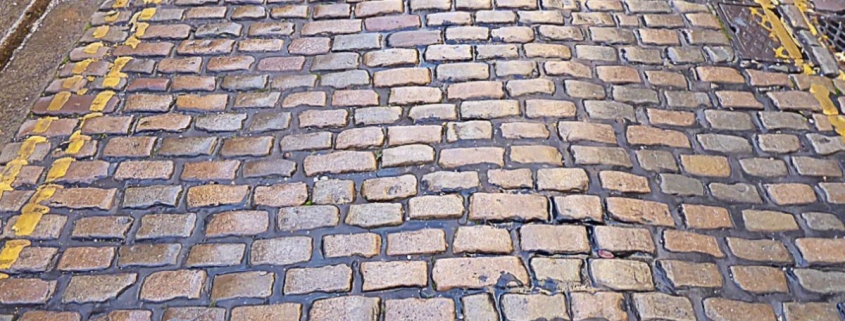The History of Cobblestone Roads
Cobblestone roads, also known as cobblestone or sett-paved streets, have a long and fascinating history that spans thousands of years. From ancient Rome to modern-day cities, cobblestone roads have been used for transportation, aesthetics, and even defense.
The earliest recorded use of cobblestone roads dates back to ancient Rome, where they were used to pave the famous Appian Way, one of the first major roads in the world. The Romans used large, irregularly shaped stones to create a durable road surface that could withstand heavy traffic and harsh weather conditions.
Throughout the Middle Ages, cobblestone roads were commonly used in Europe and other parts of the world. However, it wasn’t until the 19th century that they became widespread in urban areas. During this time, advances in transportation, including the introduction of horse-drawn carriages and bicycles, made cobblestone roads a popular choice for city planners.
The Evolution of Cobbles
One significant evolution in the use of cobblestones was the introduction of granite cobblestone setts. Granite was preferred due to its durability, strength, and ability to withstand heavy traffic. In addition, granite was readily available in many parts of the world, making it an affordable and practical option for city planners.
The popularity of cobblestone roads began to decline in the early 20th century, as the rise of the automobile and the need for smoother, more comfortable road surfaces became more important. As more and more cars were introduced on the roads, the rough surface of cobblestone roads made for an uncomfortable and sometimes even dangerous ride for drivers and passengers.
In addition to the discomfort caused by the rough surface, the vibrations caused by the uneven stones were detrimental to the vehicles. The constant jarring could cause damage to the suspension and other components, leading to increased maintenance costs for drivers and vehicle owners.
The development of new road building materials and technologies also contributed to the decline of cobblestone roads. When it was initially developed in the late 19th century, asphalt concrete (or tarmac) soon gained popularity because to its durability, adaptability, and simplicity of construction. Unlike cobblestone roads, tarmac offered a smooth, even surface that was more suitable for high-speed vehicles like cars and trucks.
The transition from cobblestone roads to tarmac took several decades, as many cities and towns around the world continued to use cobblestones for some time, even as tarmac became more widely available. In some cases, cobblestones were replaced with tarmac on major thoroughfares while smaller side streets continued to use cobblestones.
The use of cobblestones for aesthetic purposes, such as in historic districts or pedestrian walkways, also continued. Today, cobblestone roads can still be found in many cities around the world, although they are generally limited to smaller, low-traffic areas.
The decline of cobblestone roads was driven by a combination of factors, including the rise of the automobile, the need for smoother road surfaces, and the development of new road building materials and technologies. While the transition to tarmac took several decades, the benefits of smoother, more durable road surfaces eventually led to the decline of cobblestone roads as a primary means of transportation.
Modern Alternative Cobblestone
Today, there are several modern alternatives to traditional cobblestone roads. One popular option is Quicksetts, which are made from precast concrete and designed to mimic the appearance of traditional cobblestones. Quicksetts offer many of the same aesthetic benefits of traditional cobblestone roads, but with the added benefit of being more durable and easier to maintain.
Another alternative to traditional cobblestones is resin-bound paving. Resin-bound paving is made from a combination of natural aggregates and a polyurethane resin, which is applied to a stable base layer. The result is a smooth and durable surface that can be customized with a variety of colors and designs.
Despite the decline of cobblestone roads as a primary means of transportation, there is still a strong desire for cobblestone areas in many cities and towns around the world. This is due to several reasons, including:
- Aesthetic appeal: Cobblestone roads and walkways have a unique and timeless beauty that can add character and charm to a city or town. They are often associated with historic districts or cultural landmarks, and can provide a sense of nostalgia or romanticism that is difficult to replicate with modern materials.
- Durability: While cobblestone roads may not be suitable for high-speed traffic, they are still durable and can withstand heavy foot traffic and harsh weather conditions. This makes them a popular choice for pedestrian walkways and outdoor public spaces, where they can provide a long-lasting and attractive surface.
- Sustainability: Cobblestones are a natural, sustainable material that can be recycled or reused when they reach the end of their useful life. They do not require the same level of energy-intensive manufacturing as modern materials like concrete or asphalt, making them an environmentally friendly option for many applications.
- Cultural significance: Cobblestone roads have a rich cultural history that can be tied to specific regions or countries. In some cases, they are considered an important part of a city’s heritage or identity, and are protected or preserved as a cultural asset.
Overall, the desire for cobblestone areas is driven by a combination of practical and aesthetic considerations, as well as cultural and historical significance. While they may not be suitable for all applications, cobblestones can provide a unique and lasting beauty that is difficult to replicate with modern materials.
In conclusion, the history of cobblestone roads is a long and fascinating one, spanning thousands of years and multiple continents. While the popularity of traditional cobblestones has declined in recent years, the use of modern alternatives such as Quicksetts and resin-bound paving ensures that the beauty and durability of cobblestone roads will continue to be appreciated for many years to come.


